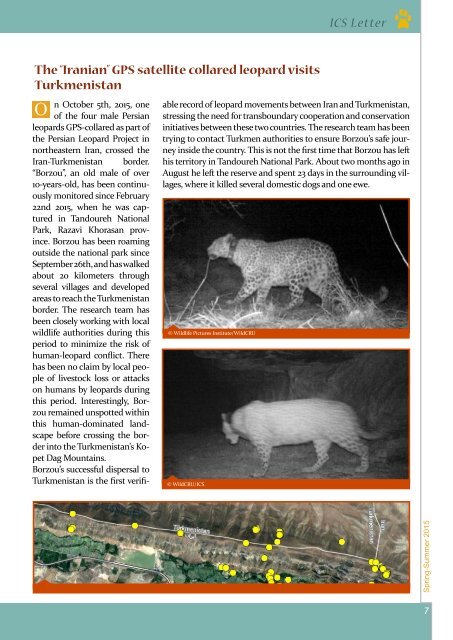ICS Letter
NewsletterICS
NewsletterICS
Create successful ePaper yourself
Turn your PDF publications into a flip-book with our unique Google optimized e-Paper software.
<strong>ICS</strong> <strong>Letter</strong><br />
The “Iranian” GPS satellite collared leopard visits<br />
Turkmenistan<br />
O<br />
n October 5th, 2015, one<br />
of the four male Persian<br />
leopards GPS-collared as part of<br />
the Persian Leopard Project in<br />
northeastern Iran, crossed the<br />
Iran-Turkmenistan border.<br />
“Borzou”, an old male of over<br />
10-years-old, has been continuously<br />
monitored since February<br />
22nd 2015, when he was captured<br />
in Tandoureh National<br />
Park, Razavi Khorasan province.<br />
Borzou has been roaming<br />
outside the national park since<br />
September 26th, and has walked<br />
about 20 kilometers through<br />
several villages and developed<br />
areas to reach the Turkmenistan<br />
border. The research team has<br />
been closely working with local<br />
wildlife authorities during this<br />
period to minimize the risk of<br />
human-leopard conflict. There<br />
has been no claim by local people<br />
of livestock loss or attacks<br />
on humans by leopards during<br />
this period. Interestingly, Borzou<br />
remained unspotted within<br />
this human-dominated landscape<br />
before crossing the border<br />
into the Turkmenistan’s Kopet<br />
Dag Mountains.<br />
Borzou’s successful dispersal to<br />
Turkmenistan is the first verifiable<br />
record of leopard movements between Iran and Turkmenistan,<br />
stressing the need for transboundary cooperation and conservation<br />
initiatives between these two countries. The research team has been<br />
trying to contact Turkmen authorities to ensure Borzou’s safe journey<br />
inside the country. This is not the first time that Borzou has left<br />
his territory in Tandoureh National Park. About two months ago in<br />
August he left the reserve and spent 23 days in the surrounding villages,<br />
where it killed several domestic dogs and one ewe.<br />
© Wildlife Pictures Institute/WildCRU<br />
© WildCRU/<strong>ICS</strong><br />
Spring-Summer 2015<br />
7


